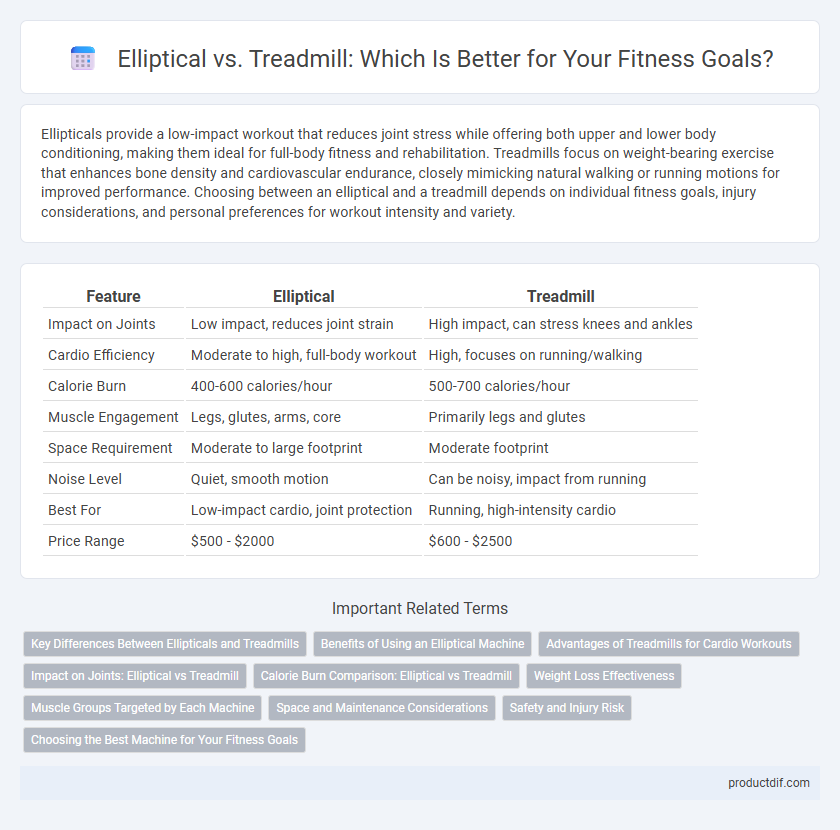Ellipticals provide a low-impact workout that reduces joint stress while offering both upper and lower body conditioning, making them ideal for full-body fitness and rehabilitation. Treadmills focus on weight-bearing exercise that enhances bone density and cardiovascular endurance, closely mimicking natural walking or running motions for improved performance. Choosing between an elliptical and a treadmill depends on individual fitness goals, injury considerations, and personal preferences for workout intensity and variety.
Table of Comparison
| Feature | Elliptical | Treadmill |
|---|---|---|
| Impact on Joints | Low impact, reduces joint strain | High impact, can stress knees and ankles |
| Cardio Efficiency | Moderate to high, full-body workout | High, focuses on running/walking |
| Calorie Burn | 400-600 calories/hour | 500-700 calories/hour |
| Muscle Engagement | Legs, glutes, arms, core | Primarily legs and glutes |
| Space Requirement | Moderate to large footprint | Moderate footprint |
| Noise Level | Quiet, smooth motion | Can be noisy, impact from running |
| Best For | Low-impact cardio, joint protection | Running, high-intensity cardio |
| Price Range | $500 - $2000 | $600 - $2500 |
Key Differences Between Ellipticals and Treadmills
Ellipticals provide low-impact cardiovascular workouts by simulating walking, running, or stair climbing without joint strain, making them ideal for users with mobility issues or injury recovery. Treadmills offer high-impact, weight-bearing exercise that mimics natural running or walking patterns, promoting bone density and muscle strengthening. Key differences include the elliptical's dual-action handles for upper body engagement versus the treadmill's focus on lower body endurance and speed control.
Benefits of Using an Elliptical Machine
Elliptical machines provide a low-impact cardiovascular workout that reduces stress on joints compared to treadmills, making them ideal for individuals with arthritis or joint pain. Their dual-action design engages both the upper and lower body, increasing calorie burn and muscle toning efficiency. Ellipticals also offer backward pedaling options and adjustable resistance levels, enhancing exercise variety and targeting different muscle groups.
Advantages of Treadmills for Cardio Workouts
Treadmills offer precise control over speed and incline, enabling tailored cardiovascular workouts that efficiently boost heart rate and endurance. They simulate natural running and walking motions, engaging more muscle groups compared to elliptical machines. High-impact treadmill exercises promote greater bone density and calorie burn, making them ideal for effective cardio and weight loss routines.
Impact on Joints: Elliptical vs Treadmill
Elliptical machines provide a low-impact cardiovascular workout by mimicking natural motion without harsh jarring, significantly reducing stress on the knees, hips, and ankles compared to treadmills. Treadmills, while effective for weight-bearing exercise, often deliver higher joint impact due to repetitive foot strikes on a hard surface, increasing the risk of joint pain and injury. Choosing an elliptical can enhance long-term joint health by promoting smooth, gliding movements that maintain fitness with minimal joint strain.
Calorie Burn Comparison: Elliptical vs Treadmill
Elliptical machines typically burn between 270-400 calories per 30 minutes depending on intensity and resistance settings, while treadmills can burn approximately 300-450 calories in the same time frame based on speed and incline. The elliptical offers low-impact cardio with simultaneous upper and lower body engagement, making it effective for calorie burning with reduced joint stress. Treadmills excel at high-intensity workouts like running or incline walking, often resulting in higher calorie expenditure for users capable of sustained effort.
Weight Loss Effectiveness
Elliptical machines provide a low-impact cardiovascular workout that effectively burns calories and promotes weight loss by engaging both upper and lower body muscles simultaneously. Treadmills offer high-intensity running or walking options that can significantly increase calorie expenditure and improve fat-burning efficiency. Studies show that while treadmills may burn more calories per hour during intense sessions, ellipticals reduce joint strain, making sustained, consistent workouts more achievable for long-term weight loss.
Muscle Groups Targeted by Each Machine
Elliptical machines primarily target the glutes, hamstrings, quadriceps, and calves while also engaging the upper body muscles, including the biceps, triceps, and shoulders through moving handlebars. Treadmills predominantly focus on lower body muscles such as the quadriceps, hamstrings, calves, and gluteus maximus, emphasizing weight-bearing cardio with minimal upper body involvement. Choosing between an elliptical and treadmill can influence muscle engagement patterns based on workout goals and overall fitness needs.
Space and Maintenance Considerations
Elliptical machines generally require less floor space than treadmills, making them ideal for smaller home gyms or apartments. Maintenance for ellipticals is typically less intensive, involving occasional lubrication and belt checks, whereas treadmills demand regular belt alignment, motor inspection, and deck lubrication to ensure smooth operation. Choosing between the two depends on available space and willingness to perform routine upkeep for optimal performance.
Safety and Injury Risk
Elliptical machines offer low-impact cardiovascular workouts by reducing joint stress, making them safer for individuals with arthritis or prior injuries compared to treadmills, which involve repetitive high-impact foot strikes. The treadmill's risk of overuse injuries like shin splints, stress fractures, and knee problems is higher due to its impact intensity and potential for tripping or falling. Ellipticals also reduce balance-related injury risks since feet remain in contact with pedals, promoting safer exercise for rehabilitation or older users.
Choosing the Best Machine for Your Fitness Goals
Elliptical machines provide low-impact cardio workouts that are ideal for reducing joint stress while improving cardiovascular health and muscle endurance. Treadmills offer high-impact exercise that effectively burns calories, enhances bone density, and boosts running performance. Selecting between an elliptical and treadmill depends on your fitness goals, such as injury prevention, calorie burning, or training specificity.
Elliptical vs Treadmill Infographic

 productdif.com
productdif.com